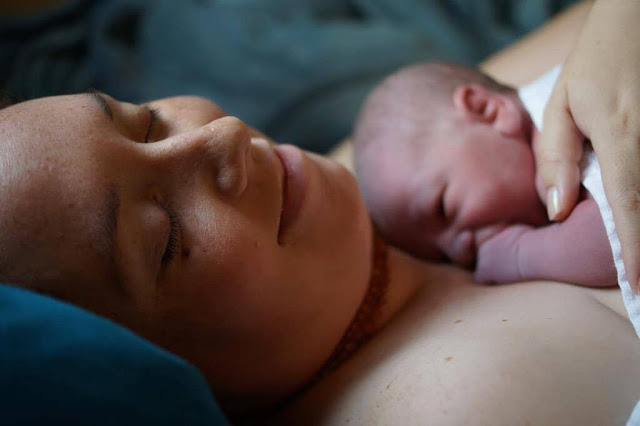I'm writing this series of posts on Kangaroo Care (KC) with dear and beautiful family, friends, and clients in mind. These are the things that I wish that I had known about kangaroo care for full term infants from the beginning. KC is SO important, mothers and babies have magically sensitive skin that gives many special benefits to both mother and baby for at least the first 9-12 months postpartum. Besides the post partum mother, other caregivers can share benefits with baby through skin to skin contact too. Find out more about the medical benefits of kangaroo care here.
 |
| PaxBaby Doula Jillian Davidsson took this photo of MamaBird Postpartum educator, Laura Brown, and super new Baby Hazel, as they hold each other close in kangaroo care |
So, How Do You Do Kangaroo Care?
1. Take your shirts OFF!! If there is one thing that you take away from this series, I hope it is that kangaroo care needs to be skin of baby's naked torso flush against skin of caregiver's naked torso; no shirts, no bras. You can regulate baby's temperature (and a myriad of other magic benefits) with your magic skin; clothes do not have magic skin and they block the effects! And so take your shirts, camis, bras OFF!!
2. Skin is made magic by C-afferent nerves, which exist most strongly ventrally - from the navel to the clavicle, posteriorly - across the upper back, and dorsally - on the forearms. These magic skin locations exists on all humans.
3. Positioning: the caregiver and baby should engage in skin to skin contact with baby flush against caregiver using the aforementioned magic body parts. This is most easily achieved with baby (in only a diaper)
a. laid bare chest flush in the center of the caregiver's bare chest; so that a clear airway (I can see nose, mouth, chest) is easily monitored. If baby has a frontal medical condition that prevents chest to chest KC, then baby should be in the bare side position (sort of wrapped around a breast) flush in the center of caregiver’s bare chest, or if babies are multiples, lay baby bare chest to each side of a breast, so that the breasts are a resting space for up to two babies each, always monitoring for a clear airway (I can see nose-mouth-chest)
b. head is at a kissable and sniffable level
c. head rests tilted to the side on caregiver's chest
d. neck is straight
e. face is uncovered
f. nose is uncovered
g. face is visible
h. arms are in a flexed position with the magic forearm skin resting against caregiver's magic chest/torso skin
i. legs are in a flexed position, often referred to as frogged position
4. Back of baby is covered with a blanket, baby carrier, or Kangaroo Care top to help retain baby's heat; if unable to do chest to chest KC, side of baby is covered with a blanket, baby carrier, or kangaroo care top to help retain baby’s heat.
5. Caregiver is upright, preferably leaned back, but not lying down flat.
6. Caregiver is not mobile.
For more info on KC:
Do you have any questions about kangaroo care? Please comment below or send me an email: rachelgaston@hotmail.com or text/phone me 814-933-5668.
My bed propped on pillows is my happy spot for holding baby in kangaroo care. Where do you like to hold baby in Kangaroo Care?
My bed propped on pillows is my happy spot for holding baby in kangaroo care. Where do you like to hold baby in Kangaroo Care?

















